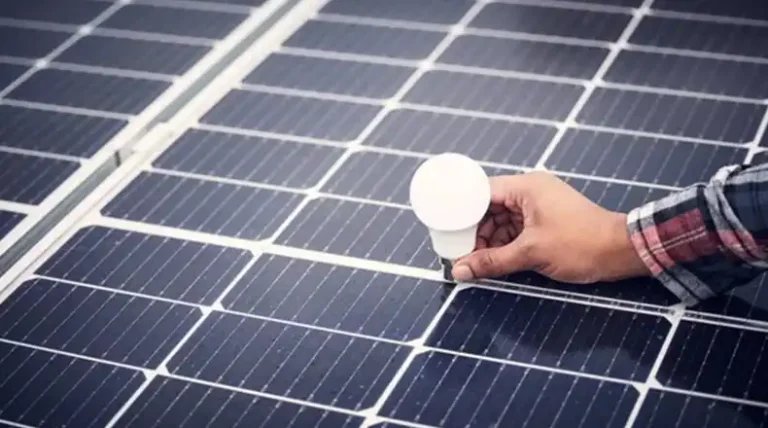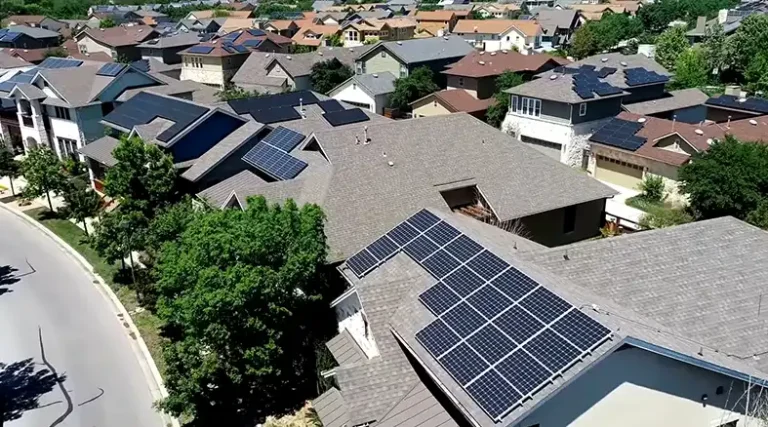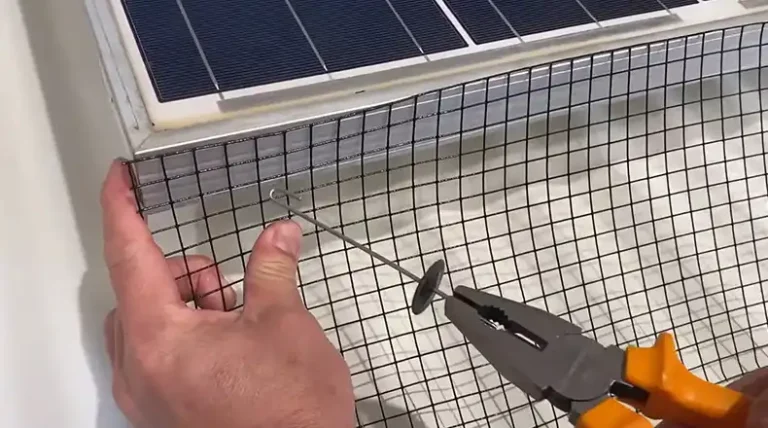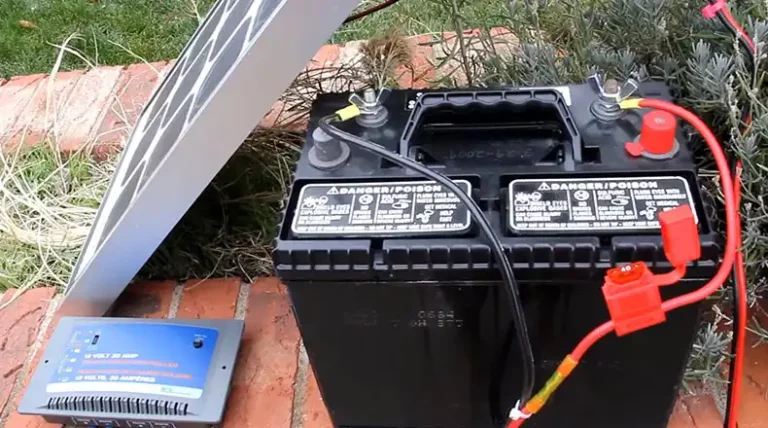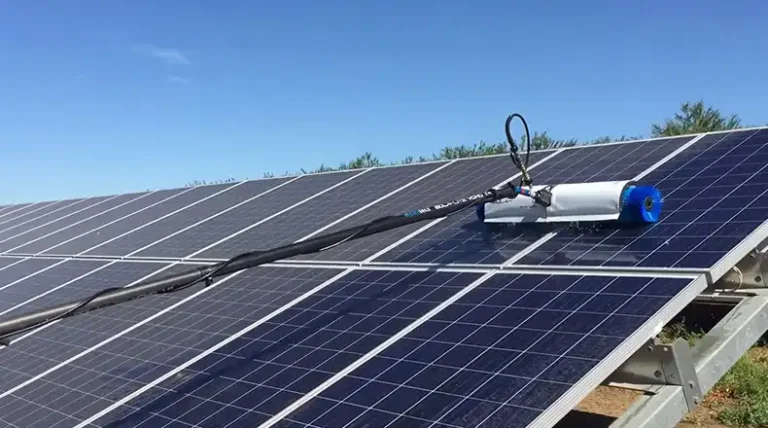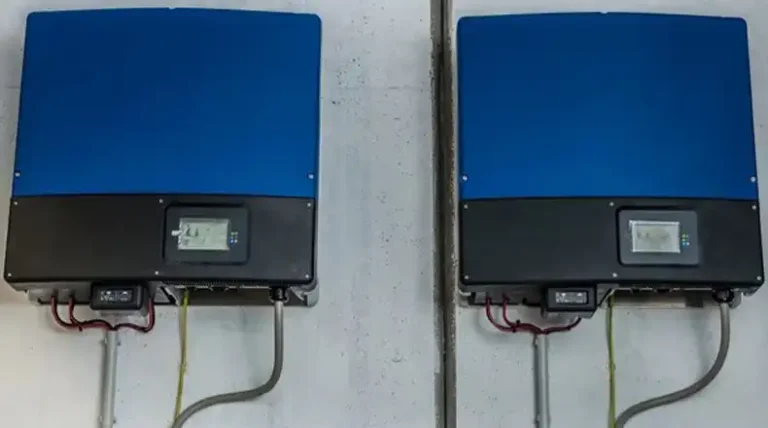Why Is There a Loss of Power Between the Solar Inverter and the Utility Meter?
Solar energy is a clean and renewable source of power that can reduce your electricity bills and carbon footprint. However, to harness solar energy, you need a system that converts sunlight into usable electricity. This system consists of two main components: the solar panels and the inverter.
The solar panels are the devices that capture the sun’s rays and convert them into direct current (DC) electricity. The inverter is the device that converts the DC electricity into alternating current (AC) electricity, which is the standard form of electricity used in most homes and businesses.
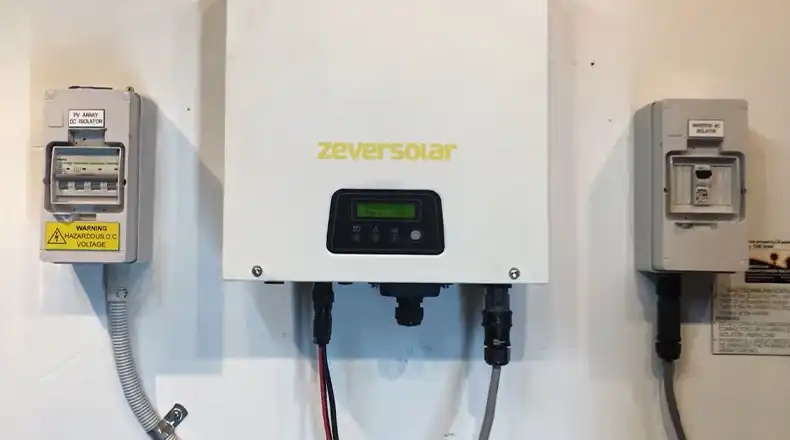
The AC electricity from the inverter is then fed to the utility meter, which measures the amount of electricity you consume from or export to the grid. The utility meter is also connected to the grid, which is the network of power lines that delivers electricity to different locations.
However, not all the electricity generated by the solar panels reaches the utility meter. There is some power loss between the inverter and the utility meter, which reduces the efficiency and performance of your solar system. This power loss can vary depending on several factors, such as the quality and condition of the components, the length and size of the cables, the accuracy of the metering, and the regulations of the utility company.
Understanding and minimizing this power loss is crucial for optimizing your solar system and maximizing your savings and returns. In this article, we will explore the sources of power loss between the inverter and the utility meter, how to quantify and track this loss, and how to minimize it with some simple tips and best practices.
What are the Sources of Power Loss
Several factors can contribute to power loss between the inverter and the utility meter. Here are some of the most common ones:
Inverter Efficiency
Inverter efficiency is the ratio of the AC output power to the DC input power of the inverter. It indicates how well the inverter converts the DC electricity from the solar panels into AC electricity for the grid. The higher the inverter efficiency, the lower the power loss.
Inverter efficiency typically ranges from 90% to 98%, depending on the type, model, and quality of the inverter. This means that 2% to 10% of the power generated by the solar panels is lost during the conversion process.
Some of the factors that affect inverter efficiency are:
Age: As inverters age, their efficiency tends to decline due to wear and tear, dust accumulation, and component degradation. Older inverters may have lower efficiency than newer ones, resulting in more power loss.
Size: The size of the inverter should match the size of the solar system. If the inverter is too small, it may not be able to handle the peak power output of the solar panels, leading to power clipping and loss. If the inverter is too large, it may operate at a lower efficiency than its optimal level, leading to power waste and loss.
Operating Temperature: The temperature of the environment where the inverter is installed can affect its efficiency. High temperatures can cause the inverter to overheat and reduce its performance. Low temperatures can cause the inverter to underperform and increase its losses. Ideally, the inverter should be installed in a well-ventilated and shaded location to avoid extreme temperatures.
Cable Losses
Cable losses are the power losses that occur due to the resistance of the cables that connect the inverter and the utility meter. Resistance is the opposition to the flow of electric current in a conductor. The higher the resistance, the more power is dissipated as heat and the less power reaches the utility meter.
Some of the factors that affect cable resistance and losses are:
Cable Length: The longer the cable, the higher the resistance and the more power is lost. Therefore, it is advisable to minimize the cable length between the inverter and the utility meter as much as possible.
Cable Thickness: The thicker the cable, the lower the resistance and the less power is lost. Therefore, it is advisable to choose cables with a sufficient gauge or cross-sectional area to handle the current and minimize the resistance.
Cable Current: The higher the current, the higher the resistance and the more power is lost. Therefore, it is advisable to choose cables that can handle the maximum current output of the inverter without overheating or causing voltage drops.
To choose the right cables for your solar system, you can use online calculators or consult a professional installer. You should also ensure proper installation and maintenance of the cables to prevent damage, corrosion, or loose connections that can increase the resistance and losses.
Metering Accuracy
Metering accuracy is the degree of agreement between the actual and the measured values of the electricity. It indicates how well the inverter and the utility meter record and display the power output and consumption of your solar system. The higher the metering accuracy, the lower the discrepancy and the perceived power loss.
Metering accuracy can vary depending on the type, model, and quality of the inverter and the utility meter. Some of the factors that affect metering accuracy are:
Calibration: Calibration is the process of adjusting the meter to match a standard or reference value. Calibration ensures that the meter readings are accurate and consistent. However, calibration can drift over time due to environmental factors, component degradation, or human error. Therefore, it is advisable to calibrate the inverter and the utility meter regularly or as per the manufacturer’s recommendations.
Maintenance: Maintenance is the process of inspecting, cleaning, and repairing the meter to ensure its proper functioning. Maintenance prevents dust accumulation, damage, or malfunction that can affect the meter readings. Therefore, it is advisable to perform preventive maintenance on the inverter and the utility meter periodically or as per the manufacturer’s instructions.
Resolution: Resolution is the smallest unit of measurement that the meter can display. Resolution affects the precision and accuracy of the meter readings. For example, if the meter has a resolution of 0.1 kWh, it can only display values in multiples of 0.1 kWh, such as 1.2 kWh or 1.3 kWh. However, the actual value may be somewhere between 1.2 kWh and 1.3 kWh, such as 1.25 kWh or 1.27 kWh. Therefore, it is advisable to choose an inverter and a utility meter with a high resolution to minimize rounding errors and discrepancies.
Power Factor
The power factor is the ratio of the real power to the apparent power in an AC circuit. Real power is the power that performs useful work, such as lighting, heating, or running appliances. Apparent power is the power that is supplied by the source, such as the inverter or the grid. The higher the power factor, the more efficient the power transfer and the lower the power loss.
The power factor typically ranges from 0 to 1, depending on the load and the source. A power factor of 1 means that the real power and the apparent power are equal, and there is no power loss. A power factor of 0 means that the real power is zero, and all the power is lost.
Some of the factors that affect power factor are:
Load Type: The type of load that is connected to the inverter or the grid can affect the power factor. Loads can be classified into resistive, inductive, or capacitive. Resistive loads, such as incandescent bulbs or heaters, have a power factor of 1, as they consume only real power. Inductive loads, such as motors or transformers, have a power factor of less than 1, as they consume both real and reactive power. Reactive power is the power that is stored and released by the load, creating a phase difference between the voltage and the current. Capacitive loads, such as capacitors or filters, have a power factor of more than 1, as they generate reactive power and correct the phase difference. Therefore, it is advisable to balance the load types to achieve a high power factor and minimize power loss.
Inverter Type: The type of inverter that is used in the solar system can affect the power factor. Inverters can be classified into string, micro, or hybrid. String inverters are the most common type of inverters, which connect multiple solar panels in series or parallel to form a string. Micro inverters are small inverters that are attached to each solar panel individually. Hybrid inverters are inverters that can integrate battery storage and grid connection. Each type of inverter has a different power factor, depending on its design, features, and settings. Therefore, it is advisable to choose an inverter with a high power factor and a suitable size and configuration for your solar system.
Power Factor Correction: Power factor correction is the process of improving the power factor by adding or removing reactive power. Power factor correction can be done by using devices such as capacitors, filters, or controllers that can adjust the voltage and the current to reduce the phase difference and the reactive power. Power factor correction can increase the efficiency and performance of the inverter and the grid, and reduce the power loss and the electricity bills. Therefore, it is advisable to consider power factor correction options for your solar system, such as choosing an inverter with a built-in power factor correction feature or installing a separate power factor correction device.
Export Restrictions
Export restrictions are the limitations imposed by the utility company on the amount of power that you can export to the grid from your solar system. Export restrictions can affect the power loss between the inverter and the utility meter, as they can prevent you from exporting excess solar power and force you to waste or curtail it.
Some of the factors that affect export restrictions are:
Grid Capacity: The grid capacity is the maximum amount of power that the grid can handle at any given time. Grid capacity can vary depending on the location, the time, the weather, and the demand. If the grid capacity is low, the utility company may limit the amount of power that you can export to the grid from your solar system, to avoid overloading or damaging the grid. This can result in power loss, as you may have to waste or curtail the excess solar power that you cannot export.
Grid Regulations: Grid regulations are the rules and policies that govern the connection and operation of your solar system to the grid. Grid regulations can vary depending on the utility company, the state, and the country. Some of the grid regulations that may affect the power export are:
Net Metering – Net metering is a policy that allows you to offset your electricity bill by the amount of power that you export to the grid from your solar system. Net metering can reduce power loss, as you can export excess solar power and receive credits or payments for it. However, net metering may have some limitations, such as caps, rates, or fees, that may reduce the benefits or incentives of exporting power to the grid.
Feed-in Tariff – Feed-in tariff is a policy that pays you a fixed rate for the power that you export to the grid from your solar system. A feed-in tariff can reduce the power loss, as you can export the excess solar power and receive payments for it. However, feed-in tariffs may have some limitations, such as quotas, contracts, or taxes, that may reduce the profitability or feasibility of exporting power to the grid.
Zero Export: Zero export is a policy that prohibits you from exporting any power to the grid from your solar system. Zero export can increase the power loss, as you have to waste or curtail all the excess solar power that you cannot use or store. Zero export may be imposed by the utility company due to grid capacity or safety issues, or by the government due to environmental or economic reasons.
To minimize the power loss due to export restrictions, you should explore the solutions for maximizing self-consumption and minimizing the grid export of your solar system, such as:
Load Shifting: Load shifting is the strategy of adjusting your energy consumption patterns to match the solar generation patterns. Load shifting can reduce power loss, as you can use more solar power when it is available and less grid power when it is not. You can implement load shifting by using timers, sensors, or smart devices that can turn on or off your appliances automatically or remotely, depending on the solar output and the grid conditions.
Energy Efficiency: Energy efficiency is the strategy of reducing your energy consumption and waste without compromising your comfort or convenience. Energy efficiency can reduce power loss, as you can use less solar power and grid power overall. You can implement energy efficiency by using energy-saving appliances, lighting, and insulation, as well as by adopting energy-conscious habits and behaviors.
How to Quantifying Power Loss
To quantify the power loss between the inverter and the utility meter, you need to compare the power output of the inverter and the power consumption of the utility meter. The difference between these two values is the power loss. To calculate the power loss, you can use the following formula:
Power loss = Inverter output – Utility meter consumption
The power loss can be expressed in watts (W), kilowatts (kW), or kilowatt-hours (kWh), depending on the unit of measurement of the inverter and the utility meter. To convert between different units, you can use the following conversions:
1 W = 0.001 kW
1 kW = 1000 W
1 kWh = 1 kW x 1 hour
For example, if your inverter output is 5 kW and your utility meter consumption is 4.8 kW, your power loss is:
Power loss = 5 kW – 4.8 kW
Power loss = 0.2 kW
To calculate the power loss over a while, such as a day, a month, or a year, you need to multiply the power loss by the duration of the period. For example, if your power loss is 0.2 kW and the duration is 24 hours, your power loss is:
Power loss = 0.2 kW x 24 hours
Power loss = 4.8 kWh
To calculate the percentage of power loss, you need to divide the power loss by the inverter output and multiply by 100. For example, if your power loss is 0.2 kW and your inverter output is 5 kW, your percentage of power loss is:
Percentage of power loss = (0.2 kW / 5 kW) x 100
Percentage of power loss = 4%
To calculate and track the power loss between the inverter and the utility meter, you can use various resources and tools, such as:
Inverter and Utility Meter Displays: Most inverters and utility meters have digital displays that show the power output and consumption in real-time or over a while. You can check these displays regularly and record the values manually or automatically. You can also access these displays remotely via online portals or mobile apps, depending on the model and features of the inverter and the utility meter.
Data Loggers and Monitoring Systems: Data loggers and monitoring systems are devices that collect, store, and transmit the data from the inverter and the utility meter to a central server or cloud service. You can access and analyze this data via online dashboards or reports that show the power output and consumption in various formats, such as graphs, charts, or tables. You can also set up alerts and notifications for any anomalies or issues that may affect the power loss.
Online Calculators and Simulators: Online calculators and simulators are web-based tools that allow you to estimate the power loss between the inverter and the utility meter based on various inputs, such as the type, size, and efficiency of the inverter, the length and size of the cables, the power factor, and the export restrictions. You can use these tools to compare different scenarios and optimize your solar system for minimal power loss.
The acceptable range of power loss between the inverter and the utility meter depends on several factors, such as the size and configuration of your solar system, the quality and condition of your components, the environmental and operational conditions, and the expectations and goals of your solar project. Generally, a power loss of less than 10% is considered normal and acceptable, while a power loss of more than 10% is considered high and unacceptable. However, you should always aim to reduce the power loss as much as possible to increase the efficiency and performance of your solar system.
What are the Ways to Minimizing Power Loss
There are several ways to minimize the power loss between the inverter and the utility meter, such as:
Selecting the Right Inverter
One of the most important factors that affect the power loss between the inverter and the utility meter is the selection of the right inverter for your solar system. You should choose an inverter that has a high efficiency and a suitable power factor, as well as other features that optimize the efficiency and minimize the loss, such as:
Maximum Power Point Tracking (MPPT): MPPT is a feature that allows the inverter to adjust the voltage and current of the solar panels to match the maximum power output at any given time. MPPT increases the efficiency and performance of the solar system and reduces power loss due to voltage drops or power clipping.
Reactive Power Control: Reactive power control is a feature that allows the inverter to adjust the reactive power output to match the power factor of the grid. Reactive power control increases the efficiency and stability of the power transfer and reduces the power loss due to phase differences or power factor correction devices.
Smart Grid Compatibility: Smart grid compatibility is a feature that allows the inverter to communicate and interact with the grid and the utility company. Smart grid compatibility enables the inverter to respond to grid signals and commands, such as export limits, demand response, or frequency regulation. Smart grid compatibility enhances the reliability and security of the grid and reduces the power loss due to grid congestion or curtailment.
Optimizing Cable Length and Size
Another important factor that affects the power loss between the inverter and the utility meter is the optimization of the cable length and size. You should minimize the cable length between the inverter and the utility meter as much as possible, and choose cables with a sufficient gauge or cross-sectional area to handle the current and minimize the resistance, as well as other features that optimize the efficiency and minimize the loss, such as:
Insulation: Insulation is the material that covers the conductor of the cable to prevent electric shocks, short circuits, or fire hazards. Insulation also reduces the heat loss and the interference from external sources, such as electromagnetic fields or radio waves. You should choose cables with high-quality and durable insulation that can withstand the environmental and operational conditions of your solar system.
Connectors: Connectors are the devices that join the cables to the inverter and the utility meter. Connectors also affect the resistance and the power loss of the cables, as well as the safety and reliability of the connections. You should choose connectors that are compatible with the cables and the components, and that have a low contact resistance and a high corrosion resistance. You should also ensure proper installation and maintenance of the connectors to prevent damage, looseness, or oxidation that can increase the resistance and the power loss.
Regularly Monitoring and Maintaining the System
Another crucial factor that affects the power loss between the inverter and the utility meter is the regular monitoring and maintenance of the system. You should regularly monitor the inverter and the utility meter readings to identify any significant discrepancies or anomalies that may indicate a problem or an issue that affects the power loss. You should also perform preventive maintenance on the inverter and the cables to ensure their optimal performance and condition, as well as address any identified issues promptly to minimize the ongoing power loss, such as:
Cleaning: Cleaning is the process of removing dust, dirt, or debris from the inverter and the cables to prevent overheating, damage, or malfunction. Cleaning also improves the appearance and the lifespan of the components. You should clean the inverter and the cables periodically or as per the manufacturer’s instructions, using a soft cloth, a brush, or a blower, and avoiding water, solvents, or abrasives that can harm the components.
Repairing: Repairing is the process of fixing or replacing any damaged or faulty parts of the inverter or the cables that affect the power loss. Repairing also restores the functionality and the efficiency of the components. You should repair the inverter or the cables as soon as possible or as per the manufacturer’s recommendations, using the appropriate tools, materials, and methods, and following the safety precautions and the warranty conditions.
Replacing: Replacing is the process of swapping or upgrading the inverter or the cables that are beyond repair or that have reached the end of their useful life. Replacing also enhances the performance and reliability of the components. You should replace the inverter or the cables when necessary or as per the manufacturer’s suggestions, using the compatible and the best available models and features, and considering the cost and the benefit of the replacement.
Utilizing Energy Management Systems
Another factor that affects the power loss between the inverter and the utility meter is the utilization of energy management systems. Energy management systems are smart devices or software that optimize energy use and minimize the grid export of your solar system. Energy management systems can reduce the power loss between the inverter and the utility meter by increasing self-consumption and decreasing the reliance on the grid, as well as other benefits, such as:
Monitoring and Controlling: Monitoring and controlling are the functions that allow you to measure and manage the energy generation and consumption of your solar system. Monitoring and controlling enable you to track the performance and the status of your solar system, as well as to adjust the settings and the preferences of your inverter and your appliances. You can access and operate these functions via online portals or mobile apps, depending on the model and features of the energy management system.
Battery Storage: Battery storage is the option that allows you to store the excess solar energy in batteries for later use. Battery storage reduces the power loss between the inverter and the utility meter by avoiding the export of surplus power to the grid and providing backup power during grid outages or peak demand periods. You can choose from different types and sizes of batteries, depending on your needs and budget, and integrate them with your inverter and your energy management system
Demand Response: Demand response is the option that allows you to adjust your energy consumption in response to grid signals and incentives. Demand response reduces the power loss between the inverter and the utility meter by shifting or reducing your load during peak demand periods or grid emergencies, and increasing your load during off-peak periods or grid surplus. You can participate in demand response programs offered by your utility company or a third-party aggregator, and receive rewards or discounts for your flexibility and cooperation.
Conclusion
In conclusion, power loss between the inverter and the utility meter is a common and inevitable phenomenon in solar systems, but it can be understood and minimized with some simple tips and best practices. By selecting the right inverter, optimizing the cable length and size, regularly monitoring and maintaining the system, and utilizing energy management systems, you can reduce power loss and increase the efficiency and performance of your solar system. This will help you save more money and energy, and contribute to a sustainable and clean-energy future.
If you have any questions or concerns about the power loss between the inverter and the utility meter, or if you need professional advice or assistance for optimizing your solar system, please contact us or visit our website for more information and resources. We are happy to help you with your solar project and ensure your satisfaction and success.
Common Related Questions
How can I measure the power loss between the inverter and the utility meter?
A: You can measure the power loss by comparing the power output of the inverter and the power consumption of the utility meter. The difference between these two values is the power loss. You can use various resources and tools to calculate and track the power loss, such as inverter and utility meter displays, data loggers and monitoring systems, or online calculators and simulators.
What is the acceptable range of power loss between the inverter and the utility meter?
A: The acceptable range of power loss depends on several factors, such as the size and configuration of your solar system, the quality and condition of your components, the environmental and operational conditions, and the expectations and goals of your solar project. Generally, a power loss of less than 10% is considered normal and acceptable, while a power loss of more than 10% is considered high and unacceptable. However, you should always aim to reduce the power loss as much as possible to increase the efficiency and performance of your solar system.
What are the benefits of minimizing the power loss between the inverter and the utility meter?
A: The benefits of minimizing the power loss are manifold, such as:
Saving more money and energy by avoiding the waste or curtailment of excess solar power and reducing the electricity bills and the grid fees.
Increasing the efficiency and performance of the solar system by maximizing the power output and consumption and minimizing the heat loss and voltage drops.
Enhancing the reliability and security of the grid by balancing the load and the source and reducing the grid congestion or instability.
Contributing to a sustainable and clean-energy future by reducing the carbon footprint and the greenhouse gas emissions of the solar system.

